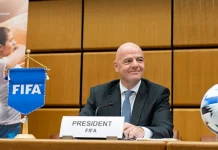The 2025-26 cycle of the FIFA tournaments is turning into the most prosperous and commercially ambitious cycle in the history of the organization. The 2025 FIFA Club World Cup will be hosted by the United States and, with the FIFA World Cup 2026 being co-hosted between the United States, Canada, and Mexico, the economic and logistic costs are higher than ever before.
Independent forecasts highlight the extent of such happenings. OpenEconomics and a joint study by FIFA and the WTO estimate that the global GDP could grow by as much as $62 billion from the two tournaments combined. Alone, the United States will derive close to 47 billion dollars of additional economic output. It is estimated that the Club World Cup will provide a direct injection to the economy of the United States of 9.6 billion dollars and will be creating around 105,000 full-time jobs. They cut across spectrums of various fields such as hospitality, construction, event management and security. In the meantime, the 2026 World Cup is expected to host 6.5 million fans and as far as the global picture is concerned, it will become a source of up to 40.9 billion dollars and help to maintain 185,000 more full-time jobs in the U.S.
Infrastructure and Legacy Planning
Improvement of stadiums and city advancements constitutes a vital part of the plans of host cities to take advantage of the economic boom. Mercedes-Benz Stadium in Atlanta is undergoing some changes including upgrading the artificial turf with natural grass that must be approved by FIFA requirements to ensure that player welfare requirements and venue compatibility is provided. The same trend is replicated in the schemes of the other host cities where the multi-billion dollar funds channeled to the host cities are in the arena of transportation, accommodation and security.
These investments have long-term tourism and other urban development hopes. This is perceived by cities as a chance to reinvent their image on the world map, to win future events and to boost the regional economies. But as these change initiatives are usually accompanied by undisclosed expenditures whether financial or social, that are not necessarily captured in the rosy macro-economic prospects.
Questions of Transparency and Economic Realization
Distribution of Economic Benefits
Though the outlook seems bright, concerns continue to exist over the evenhandedness of distribution of these economic benefits. The communities conducive to hosting the mega-events are likely to reap the horrors of the mega-event, such as displacement and unaffordable cost of living. Meanwhile broadcasting rights, sponsorship, and licensing can mean too much to FIFA and big business around the world, as opposed to the host cities and their intended citizens.
It is also feared that the generated employment will be temporary or precarious. Other critics point out that such numbers as 105,000 or 185,000 do not reflect any of the factors called sustainability, benefits, or wage. Such issues have led a number of host cities to require clearer accountability in FIFA and their country organizers of where funds will be diverted to after the event and how the communities are to be used after making the events.
Governance and Financial Oversight
The lack of transparency in the financial running of FIFA has been brought into the question again. The organization has invested in the development of legacy planning and transparency in its control of finances, but there are limited proofs of such plans. Proponents of financial controls have promoted requirements of third party audits, open contracting, and transparency of how funds will be spent, especially in cities which have set aside vast amounts of the city budget to pay back on tournament infrastructure.
Social Disruptions and Legacy Challenges
Labor Conditions and Worker Protections
The high global light on labor practices observed during the World Cup before and especially in Qatar has cast the spotlight on how the U.S and others shall approach labour protection. Although the U.S. labor market is more regulated, the scale of the projects and tight deadlines risk undermining safety standards and workers’ rights.
Among the issues that labor unions have raised include temporary labor, subcontracting, and lack of wage parity particularly among the urban construction worker-immigrants. Creating OSHA-safe conditions, transparency of wages, and safe working conditions is becoming an urgent problem in the various participating venues.
Community Displacement and Urban Stress
Gentrification pressures in host cities are already visible. More development on properties near stadiums usually forces lower-income groups to vacate their living places. The community organizers are cautious that such developments are catered more to the visiting tourists and international sponsors than they are to the local people. The effect may continue long after the last whistle has blown on affordability of the housing, neighborhood demographics and access to public services.
Attempts by some municipalities to stave off some of these effects through community liaison programs and promising to hold public hearings are of uncertain value; they do not yet appear to lead to actual security measures.
Managing Fan Experience and Operational Complexity
Cross-Border Coordination and Travel Management
The World Cup 2026 will have 48 teams and 104 matches and fans, players, government and officials would have to travel across 16 host cities in three countries. This brings in complex logistical challenges, i.e., travel visa co-ordination, compliance with multi-national regulation, and security procedure uniformity. The border management policies between the U.S., Canada and Mexico will be put to a severe test and particularly when the coordination between the federal agencies in real time does not keep up with the events demand.
Roads are also to a large extent strained. The airports, rail systems, and transportation networks have to increase operations and remain efficient and secure. Operation tests will also help in the 2025 Club World Cup which will act as a dress rehearsal and the subsequent year shortfalls will be felt in the grand event.
Ticketing, Security, and Scheduling Pressures
Initial response of the fans and media on the Club World Cup of 2025 questions the cost of the tickets, reaching the fans as well as ready stadiums. There are already complaint levels of high ticket prices, dark resale markets, and inefficiencies in digital platforms. Unless these are addressed, this may harm the zeal and drop the number of fans who come to watch major matches in the 2026 tournament.
Security agencies must also manage the threat landscape of high-profile global events, including cybersecurity threats, crowd control, and emergency responses. The scale of the tournament necessitates a coordinated, multinational security approach involving real-time data sharing and joint simulation exercises.
Governance and Ethical Considerations
Commercialization and Public Accountability
The annual forecasted income of FIFA in the 2025 Club World Cup is more than 2 billion dollars due to international broadcasting rights and corporate sponsorships. It is also possible that much of such commercial success will not go to the general population, but to FIFA and some of its stakeholders. The conflict between the selfish and personal reward of hosting mega events and the social responsibility of making such investments is a critical source of debates on the morality of mega events.
There are calls by campaigners to include binding legacy contracts that will make sure that investments made by the host cities will be of benefit to the general needs of the people even after the period of the event. Such promises can be in the form of promises on affordable housing, better transportation systems, and inclusive social spaces.
Sustainability Goals and Environmental Scrutiny
Both FIFA tournaments are said to have significantly focused on protecting the environment. Organizers have ensured that they will carry out carbon-neutral activities, reduce garbage, and green construction initiatives. The skepticism has been raised by the environmental monitors mainly in the areas of carbon emissions with international travel as well as the massive venue buildings.
With no independent enforcement body ensuring compliance, critics fear these sustainability initiatives may serve more as branding exercises than substantive commitments. The scrutiny is likely to intensify in the coming year, especially if measurable progress is not reported.
Perspectives on the 2025-26 Tournament Outlook
Economic analyst Victor das Cencao aptly summarized the dual nature of these tournaments, noting that they
“represent a crossroad where global spectacle meets local realities — where economic hopes must be measured against social and ethical responsibilities.”
President Trump just signed an Executive Order establishing a @WhiteHouse Task Force for the 2026 @FIFAWorldCup.
Happening now in the Oval Office… pic.twitter.com/w7BV2N339w
— Dan Scavino (@Scavino47) March 7, 2025
His remarks highlight the broader narrative now defining the 2025-26 cycle: the tension between ambitious global growth and the complex realities on the ground.
As the 2025 Club World Cup unfolds and preparations accelerate for the 2026 World Cup, the outcome will hinge not only on FIFA’s ability to deliver operationally but also on how well it balances its financial ambitions with the expectations of transparency, social responsibility, and community empowerment. The tournaments will test whether global sporting events can evolve beyond economic spectacle into truly inclusive platforms for sustainable development.













